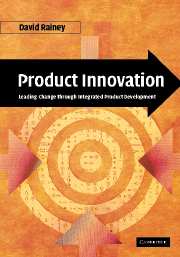Book contents
- Frontmatter
- Contents
- Preface
- Acknowledgements
- Part I Product innovation and strategic logic
- 1 Introduction to product innovation and new-product development
- 2 Strategic logic of product innovation
- 3 The new-product development process and organizational aspects
- Part II Establishing the foundation: the conceptual level
- Part III Methods and techniques for analysis and decision making
- Part IV The operational level and concluding remarks
- Glossary
- References
- Select bibliography
- Index
1 - Introduction to product innovation and new-product development
Published online by Cambridge University Press: 10 August 2009
- Frontmatter
- Contents
- Preface
- Acknowledgements
- Part I Product innovation and strategic logic
- 1 Introduction to product innovation and new-product development
- 2 Strategic logic of product innovation
- 3 The new-product development process and organizational aspects
- Part II Establishing the foundation: the conceptual level
- Part III Methods and techniques for analysis and decision making
- Part IV The operational level and concluding remarks
- Glossary
- References
- Select bibliography
- Index
Summary
Introduction
Overview
Product innovation is the overarching management framework for making incremental changes and improvements to products, services, and processes. It includes the conceptualization, design, development, validation, and commercialization of new products for customers and markets in concert with the prevailing conditions and trends. Product innovation involves the creative responses and solutions for meeting the needs and expectations of customers and market(s), the driving forces in the business environment, and the strategic requirements of the organization. Product innovation runs the gamut from improving existing products to discovering entirely new ways of satisfying customers and stakeholders. From an internal perspective, product innovation depends on the knowledge, experience, capabilities, resources, and the prevailing technologies of the organization. From an external perspective, product innovation focuses on customer and stakeholder needs, wants, and expectations. Customers desire excellent products and services with exceptional value, outstanding benefits, high quality, and assured reliability. Meeting such specifications is the exciting challenge of product innovation.
Product innovation is challenging because of the complexities of the business environment, the changing needs of customers and markets, the effects of competition, and the difficulties associated with understanding the present and forecasting the future. However, the complexities of product innovation are simplified in most organizations because there are common pathways to define and describe the processes and methods used for developing new products, and the organization has an information system to support the required analysis and decision making.
- Type
- Chapter
- Information
- Product InnovationLeading Change through Integrated Product Development, pp. 5 - 52Publisher: Cambridge University PressPrint publication year: 2005



